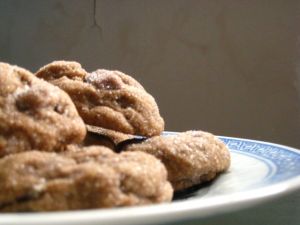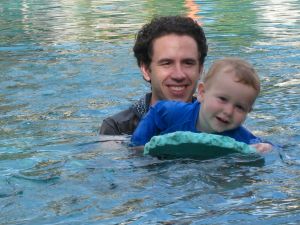We opt for the Western/Asian mixed pack, and thus we usually get an assortment of salad greens, tomatoes, bok choy, celery, carrots, eggplant, potatos, and all sorts of squash/winter melons that I never know quite what to do with. But last week, amidst the various greens and dirt-covered carrots, we got ginger. Ginger! Fresh-from-the-ground ginger. Still-dirty ginger. Of course ginger has to be locally grown somewhere, but, wow. This was a gift I did not expect.
The flavor of Hong Kong-grown ginger was familiar ... sharp, spicy, warm, pungent. But it was somehow a little fresher, and also completely lacking in bitterness. I know, I've never thought of grocery-store ginger as bitter either, but this was so un-bitter that it completely changed how I think about ginger. And the best thing? No fibers, no strings---just crisp, firm flesh, easy to slice or mince as fine as you like.
Immediately upon discovery visions of candied ginger filled my head---specifically, chocolate-dipped candied ginger. Elegant, sophisticated, and completely delicious. I decided then and there that this would be my Christmas present for the Hong Kong crowd, and they would all see me as the pastry chef I used to be. Sigh. This isn't the first time that Christmas plans have, um, over-reached.
The candying procedure itself was straightforward (I used instructions from David Lebovitz) and it's basically the same process as candying ornage rind. But after cooking the ginger in the syrup, you have a choice---either to drain the ginger from the syrup, dip in granulated sugar and let dry overnight, or store in the syrup. Of course what I had imagined was the dry version, but I hadn't thought through the process to the point of letting it dry on a rack overnight. What's the problem, you say? One word: cockroaches.
Not that we've seen any, let me hasten to add, but that doesn't mean much. We know cockroaches are a reality in Hong Kong, and in an old building like ours it's almost a given. But I'm as afraid of the chemicals used to kill cockroaches as I am of the little guys themselves, so I've developed an obsession about doing the dishes, sweeping and taking out the trash. Truly, I've never been concerned about leaving a few dishes in the sink all day, and I've certainly never felt a need to sweep after each meal, but this is my new reality. Dirty dishes hardly last 5 minutes in this kitchen, friends. So leaving sugary, candied ginger slices out on the counter overnight? No way.
I drained some of the ginger and let it dry on a rack in the refrigerator, just to see what would happen, but no luck. It's just too moist in there. (For that matter, the humidity is out of control right now, so maybe they wouldn't have dried properly on our counter anyway?)
Alas, no elegant, dark-chocolate-dipped ginger for me. What I do have, though, is a whole jar filled with syrupy sweet, chewy ginger slices and lovely ginger-spiked syrup...just right for adding to cocktails, pouring over ice cream, pouring over oatmeal!, or using in salad dressings. And I have these cookies, which are so comforting and cozy I can almost forgive them for not being the confection I wanted.
(probably my all-time favorite cookies … from a Martha Stewart Living magazine years ago)
- 7 ounces semisweet chocolate (or good quality chocolate chips)
- 1 ½ cups +1 tbsp all-purpose flour
- 1 1/4 teaspoon ground ginger
- 1 teaspoon ground cinnamon
- ¼ teaspoon ground cloves
- 1 teaspoon ground nutmeg
- 1 tablespoon cocoa powder
- 8 tablespoons (1 stick) unsalted butter
- 1 tablespoon freshly grated ginger (or a couple tablespoons chopped candied ginger)
- ½ cup dark brown sugar, packed
- ½ cup molasses
- 1 teaspoon baking soda
- ¼ cup granulated sugar
Line two baking sheets with parchment. Chop chocolate into 1/4-inch chunks; set aside. In a medium bowl, sift together flour, ground ginger, cinnamon, cloves, nutmeg, and cocoa.
In the bowl of an electric mixer, fitted with the paddle attachment, beat butter and grated ginger until whitened, about 4 minutes. Add brown sugar; beat until combined. Add molasses; beat until combined. (Note: there is no electric mixer in this tiny kitchen. A spatula works just fine, as long as the butter is soft enough, but don't let it be too soft and melty either. A KAF dough whisk is brilliant for this.)In a small bowl, dissolve baking soda in 1 1/2 teaspoons boiling water. Beat half of flour mixture into butter mixture. Beat in baking-soda mixture, then remaining half of flour mixture. Mix in chocolate; turn out onto a piece of plastic wrap. Pat dough out to about 1 inch thick; seal with wrap; refrigerate until firm, 2 hours or more.
Preheat oven to 325°F. Roll dough into 1 1/2- inch balls; place 2 inches apart on baking sheets. Refrigerate 20 minutes. Roll in granulated sugar. Bake until the surfaces crack slightly, 10 to 12 minutes. Let cool 5 minutes; transfer to a wire rack to cool completely, which you only need to do if you plan to transport them. Otherwise, eat warm, and preferably with a cold glass of milk. Yields: 2 dozen cookies.















